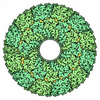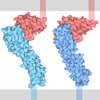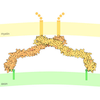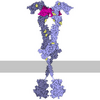[English] 日本語
 Yorodumi
Yorodumi- PDB-9kkj: Structure of Nectin-4 D1 domain in complex with the Fab fragment ... -
+ Open data
Open data
- Basic information
Basic information
| Entry | Database: PDB / ID: 9kkj | ||||||
|---|---|---|---|---|---|---|---|
| Title | Structure of Nectin-4 D1 domain in complex with the Fab fragment of 9MW2821 mAb | ||||||
 Components Components |
| ||||||
 Keywords Keywords | IMMUNE SYSTEM / antibody-antigen complex | ||||||
| Function / homology |  Function and homology information Function and homology informationNectin/Necl trans heterodimerization / negative regulation of natural killer cell mediated cytotoxicity / Adherens junctions interactions / heterophilic cell-cell adhesion / homophilic cell-cell adhesion / adherens junction / virus receptor activity / receptor ligand activity / extracellular exosome / identical protein binding / plasma membrane Similarity search - Function | ||||||
| Biological species |   Homo sapiens (human) Homo sapiens (human) | ||||||
| Method | ELECTRON MICROSCOPY / single particle reconstruction / cryo EM / Resolution: 3.26 Å | ||||||
 Authors Authors | Wen, H.Y. | ||||||
| Funding support | 1items
| ||||||
 Citation Citation |  Journal: J Biol Chem / Year: 2025 Journal: J Biol Chem / Year: 2025Title: Structural basis of nectin-4 recognition by the antibody-drug conjugate 9MW2821. Authors: Peng Fang / Meng You / Haiying Wen / Yuxia Cao / Wei Zhou / Xiaohong Zhu / Lei Shi / Xiaowei Sun / Kaiying Li / Wendi Li / Jin Wang / Hai Wu / Xiaoding Tan /  Abstract: Nectin-4, a membrane protein highly expressed in multiple solid tumors, has become an attractive target for antibody-drug conjugate development. We designed and developed 9MW2821, an anti-nectin-4 ...Nectin-4, a membrane protein highly expressed in multiple solid tumors, has become an attractive target for antibody-drug conjugate development. We designed and developed 9MW2821, an anti-nectin-4 antibody-drug conjugate with an enzymatically cleavable valine-citrulline linker and monomethyl auristatin E as the payload. Although 9MW2821 has shown good efficacy and safety in multiple solid tumors in clinical trials, the interaction between 9MW2821 and nectin-4 at the molecular level remains unclear. In this study, we solved the structure of the antigen-binding fragment of 9MW2821 in complex with nectin-4 at a resolution of 3.26 Å using single-particle cryo-EM. The structure shows that 9MW2821 binds the front β-sheet of nectin-4 D1 through three complementarity-determining region loops from the heavy chain and two complementarity-determining region loops from the light chain. The binding involves extensive hydrogen bonds and hydrophobic interactions. The buried surface area is more than 1600 Å. Mutagenesis studies revealed that four residues (Q77, E78, H83, and E95) of nectin-4 contributed significantly to the binding of 9MW2821 monoclonal antibody (mAb). The structure also shows that 9MW2821 mAb blocks nectin-4 homodimer formation by competing with the nectin-4 partner D1 domain for part of the nectin-4 surface area. Furthermore, 9MW2821 mAb prevents nectin-4 from interacting with nectin-1 and T-cell immunoglobulin and immunoreceptor tyrosine-based inhibitory motif domain, enhancing the activation of NK cells. Based on the structure of the nectin-4 D1-9MW2821 antigen-binding fragment complex resolved in this study, we have elucidated the molecular mechanism of 9MW2821 in cancer therapy. The findings provide a basis for optimizing future mAbs targeting nectin-4. | ||||||
| History |
|
- Structure visualization
Structure visualization
| Structure viewer | Molecule:  Molmil Molmil Jmol/JSmol Jmol/JSmol |
|---|
- Downloads & links
Downloads & links
- Download
Download
| PDBx/mmCIF format |  9kkj.cif.gz 9kkj.cif.gz | 115.3 KB | Display |  PDBx/mmCIF format PDBx/mmCIF format |
|---|---|---|---|---|
| PDB format |  pdb9kkj.ent.gz pdb9kkj.ent.gz | 88.2 KB | Display |  PDB format PDB format |
| PDBx/mmJSON format |  9kkj.json.gz 9kkj.json.gz | Tree view |  PDBx/mmJSON format PDBx/mmJSON format | |
| Others |  Other downloads Other downloads |
-Validation report
| Summary document |  9kkj_validation.pdf.gz 9kkj_validation.pdf.gz | 1.4 MB | Display |  wwPDB validaton report wwPDB validaton report |
|---|---|---|---|---|
| Full document |  9kkj_full_validation.pdf.gz 9kkj_full_validation.pdf.gz | 1.4 MB | Display | |
| Data in XML |  9kkj_validation.xml.gz 9kkj_validation.xml.gz | 32.1 KB | Display | |
| Data in CIF |  9kkj_validation.cif.gz 9kkj_validation.cif.gz | 44.9 KB | Display | |
| Arichive directory |  https://data.pdbj.org/pub/pdb/validation_reports/kk/9kkj https://data.pdbj.org/pub/pdb/validation_reports/kk/9kkj ftp://data.pdbj.org/pub/pdb/validation_reports/kk/9kkj ftp://data.pdbj.org/pub/pdb/validation_reports/kk/9kkj | HTTPS FTP |
-Related structure data
| Related structure data |  62389MC M: map data used to model this data C: citing same article ( |
|---|---|
| Similar structure data | Similarity search - Function & homology  F&H Search F&H Search |
- Links
Links
- Assembly
Assembly
| Deposited unit | 
|
|---|---|
| 1 |
|
- Components
Components
| #1: Antibody | Mass: 23965.576 Da / Num. of mol.: 1 Source method: isolated from a genetically manipulated source Source: (gene. exp.)   |
|---|---|
| #2: Antibody | Mass: 23235.301 Da / Num. of mol.: 1 Source method: isolated from a genetically manipulated source Source: (gene. exp.)   |
| #3: Protein | Mass: 12363.739 Da / Num. of mol.: 1 Source method: isolated from a genetically manipulated source Source: (gene. exp.)  Homo sapiens (human) / Gene: NECTIN4, LNIR, PRR4, PVRL4 / Production host: Homo sapiens (human) / Gene: NECTIN4, LNIR, PRR4, PVRL4 / Production host:  Homo sapiens (human) / References: UniProt: Q96NY8 Homo sapiens (human) / References: UniProt: Q96NY8 |
| Has protein modification | Y |
-Experimental details
-Experiment
| Experiment | Method: ELECTRON MICROSCOPY |
|---|---|
| EM experiment | Aggregation state: PARTICLE / 3D reconstruction method: single particle reconstruction |
- Sample preparation
Sample preparation
| Component | Name: Nectin-4 D1 domain in complex with the Fab fragment of 9MW2821 mAb Type: COMPLEX / Entity ID: all / Source: RECOMBINANT | |||||||||||||||
|---|---|---|---|---|---|---|---|---|---|---|---|---|---|---|---|---|
| Molecular weight | Experimental value: NO | |||||||||||||||
| Source (natural) | Organism:  | |||||||||||||||
| Source (recombinant) | Organism:  Homo sapiens (human) Homo sapiens (human) | |||||||||||||||
| Buffer solution | pH: 7.5 | |||||||||||||||
| Buffer component |
| |||||||||||||||
| Specimen | Embedding applied: NO / Shadowing applied: NO / Staining applied: NO / Vitrification applied: YES | |||||||||||||||
| Vitrification | Cryogen name: ETHANE |
- Electron microscopy imaging
Electron microscopy imaging
| Experimental equipment |  Model: Titan Krios / Image courtesy: FEI Company |
|---|---|
| Microscopy | Model: TFS KRIOS |
| Electron gun | Electron source:  FIELD EMISSION GUN / Accelerating voltage: 300 kV / Illumination mode: FLOOD BEAM FIELD EMISSION GUN / Accelerating voltage: 300 kV / Illumination mode: FLOOD BEAM |
| Electron lens | Mode: BRIGHT FIELD / Nominal defocus max: 2200 nm / Nominal defocus min: 1000 nm / Calibrated defocus min: 700 nm / Calibrated defocus max: 2500 nm / Cs: 2.7 mm |
| Specimen holder | Cryogen: NITROGEN / Specimen holder model: FEI TITAN KRIOS AUTOGRID HOLDER |
| Image recording | Electron dose: 60 e/Å2 / Film or detector model: GATAN K3 BIOQUANTUM (6k x 4k) |
- Processing
Processing
| CTF correction | Type: PHASE FLIPPING AND AMPLITUDE CORRECTION |
|---|---|
| 3D reconstruction | Resolution: 3.26 Å / Resolution method: FSC 0.143 CUT-OFF / Num. of particles: 152403 / Symmetry type: POINT |
 Movie
Movie Controller
Controller


 PDBj
PDBj







